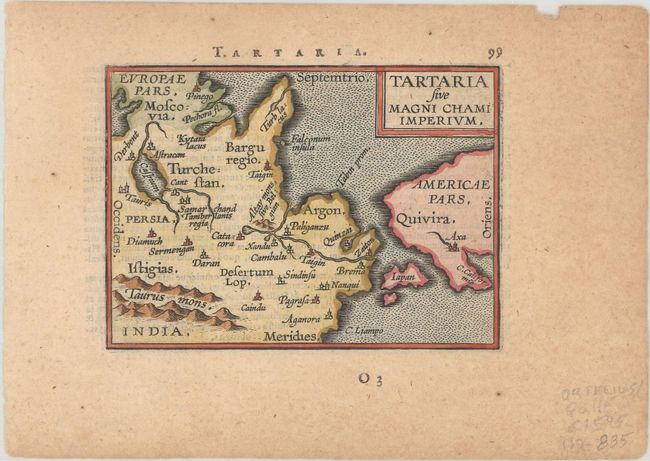Subject: Northern Asia
Period: 1601 (published)
Publication: Epitome Theatri Orteliani
Color: Hand Color
Size:
4.3 x 3.1 inches
10.9 x 7.9 cm
While designed to illustrate the expansive kingdom of the Great Khan in Asia, this tiny map's main feature is the unnamed strait separating Asia and North America based on the theory of Giacomo Gastaldi. Near the southern entrance to this straight is a large and strangely shaped Japan. In North America, the city of Axa and C. Califormio are named. Latin text on verso.
The first pocket-sized atlas, Spieghel der Wereld, was based on Ortelius' Theatrum Orbis Terrarum. The maps were engraved on copper by Filips Galle and represented all regions around the world. The maps were accompanied by text prepared by Peter Heyns, who used the text from the Theatrum. The numbers printed above the maps, adjacent to the letterpress title, corresponded with the number of the map within the Theatrum. This innovative, small atlas was designed to reach the lower middle class, and was a commercial success, prompting numerous reprints and imitations. The first edition of the Spieghel der Wereld was published in 1577, with subsequent editions published in French in 1579 and 1583, Dutch in 1583 and 1596, and Latin in 1585. Apparently dissatisfied with the quality of the plates in the Spieghel der Wereld, Galle began a new edition in 1588, commonly known as the Epitome, replacing some of the old plates with newly engraved ones. The new plates had a cleaner style with simple double-lined borders. The Epitome was quite popular, and was published in editions until 1602. Over the years Galle gradually introduced more new maps, both adding to and replacing the originals. By the final edition in 1602, only 10 of the original plates from the Spieghel remained. After 1598, the plates were passed to Jan B. Vrients, who retouched some of the plates and published the final editions of the Epitome in 1601 and 1602.
References: Burden #125; King (2nd ed.) pp. 64-65; Van der Krogt (Vol. III) #8050:332.
Condition: A
A crisp impression with very light toning and a small chip along the top edge of the sheet.


